ASM Metals HandBook Vol. 14 - Forming and Forging
Подождите немного. Документ загружается.

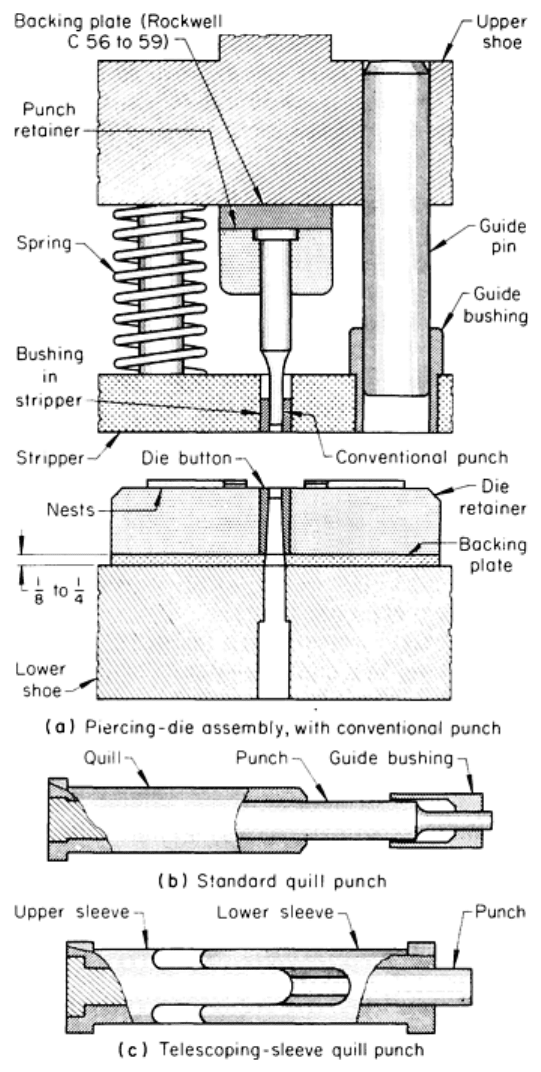
Fig. 6
Typical piercing die, and three types of punches used. See text for discussion. Dimensions given in
inches
Small workpieces are generally pierced in compound dies that blank and pierce in the same stroke. Piercing is also done
in the stations of a progressive die or a transfer die.
Any of these dies can be constructed as multiple dies, in which two or more workpieces are pierced at each stroke of the
press. Additional information on dies is available in the article "Blanking of Low-Carbon Steel" in this Volume.
Punches. Figure 6 shows three types of punches used for piercing: conventional, standard quill, and telescoping-sleeve
quill. Conventional punches are generally available with a standard maximum shank diameter of 25 mm (1 in.), and they
can be used to pierce round, square, oblong, or rectangular holes that have a size and shape not exceeding 25 mm (1 in.)

in diameter or a size and shape that can be machined or ground on the end of the shank, as shown in Fig. 6(a). Punch
shanks are also available in other sizes and shapes. Standard-size punch retainers, backing plates, die buttons, and die
button retainers are also generally available.
The head-type punch shown in Fig. 6(a) is held by a carefully positioned and ground punch retainer. This type of punch
cannot be replaced without removing the retainer. Headless punches are available with locking devices that permit
replacement without retainer removal.
A spring-loaded and guided stripper is incorporated into the die design. Conventional punches for small-diameter holes
and accurately spaced holes are supported and guided by hardened bushings pressed into the guided stripper plate.
Piloting punches can also be guided in the same manner. For larger punches that do not need guidance or support,
clearance holes are drilled in the stripper plate, and guide bushings for both the punch and the plate are omitted.
Figures 6(b) and 6(c) show two types of quill punches that replace conventional punches when piercing conditions are
more severe or when more support is required for the punch when piercing small-diameter and accurately spaced holes to
close tolerances. The type shown in Fig. 6(b) was designed to hold and align a small-diameter punch. The quill containing
a close-fitting punch is pressed into the punch retainer. The punch can easily be changed and still maintain the original
alignment and fit in the retainer. A punch guide bushing is used in the stripper plate, and a hardened backup plate supports
the head of the punch. Quills are available for punches with body diameters ranging from 1.0 to 9.52 mm (0.040 to 0.375
in.). The nib or end can be ground to a smaller diameter if desired.
The telescoping-sleeve quill punch shown in Fig. 6(c) provides complete support to small-diameter punches and
eliminates the weaknesses encountered in other punch-mounting designs. The upper part of the sleeve is press fitted into
the punch retainer; the lower part, into the guided stripper plate. The inside diameter of the sleeve will accommodate
punch bodies ranging from 0.38 to 9.52 mm (0.015 to 0.375 in.) in diameter. However, a punch body at the larger end of
the range and with a ground nib is suggested for best results. When piercing holes in printed circuit boards, a 2° cone-type
taper is ground on the bottom surface of the lower sleeve to concentrate the holding and stripping force at the edge of the
hole.
Quill punches have been used to pierce holes in low-carbon steel having a thickness up to twice the punch diameter.
Supporting sleeves or quills can be used for long, narrow punches of rectangular, oblong, or other shape.
Piercing dies can be ground into a hardened die block, or they can be die buttons that are press fitted into a die retainer, as
shown in Fig. 6(a). To coordinate the quill, guide bushing, and die button, the punch retainer, stripper plate, and die
retainer can be clamped together and jig bored and ground at the same time. This is possible because the quill, guide
bushing, and die button are available with the same body diameters.
Guided Strippers. For all three types of punches, the function of the guided stripper is threefold. On the downstroke,
the spring-actuated stripper contacts the work metal ahead of the punches and acts as a hold-down. On the upstroke, the
metal is stripped from around the punches. The third function is to guide small punches. To ensure that the force at the
points of contact and release is sufficient to accomplish the stripping, stripper springs must exert the calculated force in
the open-die position (not just in the closed-die position).
Self-Contained Tools. Piercing tools can also be purchased as individual units consisting of frame, punch, die, and
spring or hydraulic strippers. The self-contained unit is not attached to the press ram, but is located, pinned, and bolted to
a die plate, template, or T-slot plate mounted on the bed of any type of press having adequate shut height. The units can
be reused by relocating, pinning, and bolting. They can be used singly or in groups and with notching units of the same
construction. Punch and die sizes can be replaced as desired, and standard sizes and shapes are available for piercing
thicknesses up to 19 mm ( in.). The units are available in various styles for the horizontal and vertical piercing of flat or
flanged workpieces.
Tool Materials. The materials used for piercing punches and dies are selected to suit the service requirements. In
general, the materials used are the same as those for blanking (see the article "Blanking of Low-Carbon Steel" in this
Volume).
Piercing involving unusual shock and high impact may require a shock-resistant tool steel such as S7. As in blanking, M2
high-speed steel is used for long punch life, particularly in piercing thicker steel, or where high abrasion resistance is

required. In Example 7 in this article, a cam-actuated punch made of an air-hardening tool steel was replaced by a punch
made of low-carbon steel, carburized and hardened. This change increased tool life tenfold.
Information on the selection of tool material and data on tool life are given in the article "Selection of Material for
Blanking and Piercing Dies" in this Volume.
Piercing of Low-Carbon Steel
Use of Single-Operation Dies
Single-operation piercing dies are used:
• When piercing is the only operation to be performed
•
When the holes to be pierced are so close to the edge of the work that the incorporation of a piercing
operation into a compound die would weaken the die elements
• When the required accuracy or the sequence of operations prevents the
inclusion of piercing in
compound, progressive, or transfer dies
In large work, such as panels for automobiles, holes are often pierced in a separate operation for numerous reasons. For
example, the holes may distort during forming, accuracy of position may be impaired if holes are pierced before forming,
or separate operations may provide a more balanced work load and reduce maintenance.
As an example, when a hole is pierced and coined to a bevel with the same punch, coining extrudes an excessive burr
between the punch and the die unless a close punch-to-die clearance is maintained. Die maintenance can be reduced by
using separate piercing and coining dies.
Piercing of Low-Carbon Steel
Use of Compound Dies
Compound dies are used for most piercing operations in which accuracy of position is important. Except for the
production of small lots, the use of a compound die is usually the most economical method for making a pierced and
formed part to commercial tolerances. The following example describes the use of a compound die to blank and pierce a
U-shaped bracket before it was formed.
Example 1: Piercing Five Holes with a Compound Blank-and-Pierce Die.
The mounting bracket shown in Fig. 7 was made of 4.55 mm (0.179 in.) thick hot-rolled 1010 to 1025 steel strip, 200 mm
(7 in.) wide, in two operations: blank and pierce, then U-form. A compound die was used to blank the outline and
pierce three round holes and two slots. The holes were reamed to size in a secondary operation to hold the 0.025 mm
(0.001 in.) tolerance on the diameter. The compound die was made of oil-hardening tool steel (O2) hardened to 58 HRC.
Punch-to-die clearance was 5% of stock thickness per side.
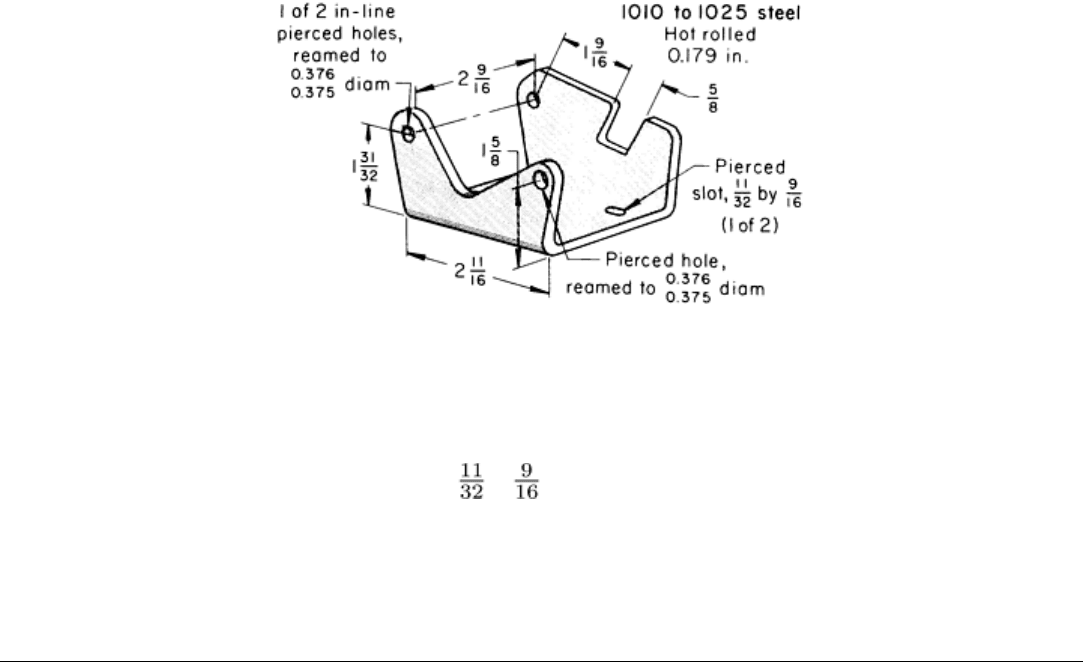
Fig. 7 Bracket that was blanked and pierced in a compound die before being formed.
Dimensions given in
inches
The blank was located by pins in the 8.7 × 14 mm ( × in.) slots for the forming operation. A spring-loaded pressure
pad held the blank firmly against the punch during forming. To overcome springback, the flanges were overbent by 2 to
3°. The forming die was made of air-hardening tool steel (A2).
Total tolerance on location of the in-line holes was 0.25 mm (0.010 in.). Production lots were 50 to 100 pieces. Expected
die life was 15,000 to 20,000 pieces before regrinding.
Piercing of Low-Carbon Steel
Use of Progressive Dies
Progressive dies perform blanking, piercing, and other operations in successive stations of a die. Each station in a
progressive die is similar to a simple die or a compound die. The workpiece in a progressive die remains connected to the
strip of work metal until the last station in the die, so that the feeding motion carries the work from station to station.
In a progressive die, piloting holes and notches are pierced in the first station. Other holes can be pierced in any station if
they are not affected by subsequent cutting or forming. Holes for which the relative position is critical are pierced in the
same station; other holes are distributed among several stations if they are close together or near the edge of a die
opening. Tolerances on hole shape, size, or location dictate whether holes are pierced before or after the part is formed.
It is often advisable to add idle stations or to distribute the work over one or two additional stations, so that holes will not
be pierced near the edge of a die block. The die block is therefore stronger, and there is less chance of the die cracking in
operation or fabrication. Adding stations also allows better support for the piercing punches and increases strength to the
strip.
Progressive dies are more expensive than a set of single-operation dies for the same part; therefore, progressive dies are
generally used for high production. However, because one part is made at each press stroke, direct labor costs are greatly
reduced, and one operator can often attend to more than one progressive die. Manufacturing costs can also be reduced by
making a pierced and formed part in a progressive die, rather than in two separate dies (one compound and one single-
operation die).
The amount of scrap produced in progressive dies is generally high because the nesting of parts is somewhat limited and
because material must be provided for connecting tabs and carrier strips. A fully automatic press with cutoff, feed,
straightener, and coil cradle or reel is normally used with a progressive die; therefore, press costs are high. Pierced parts
can sometimes be made most economically in a progressive die by using coil stock that is the exact width of the
developed blank. In the following example, the high-volume production of a bracket in a progressive die is compared
with the production of smaller quantities in separate operations in utility tooling.
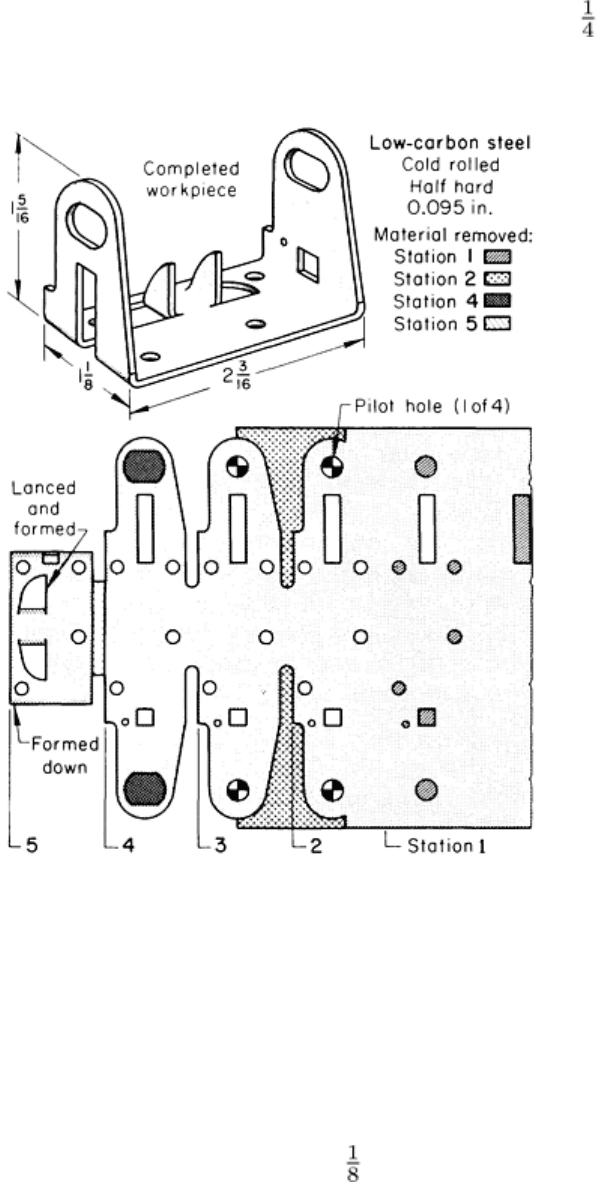
Example 2: Producing a Bracket in Large Quantities in a Progressive Die and in
Small Lots with Utility Tooling.
Figure 8 shows a bracket and the strip development for producing it in a five-station progressive die in a 670 kN (75 tonf)
mechanical press that had a 102 mm (4 in.) stroke, an air-actuated stock feeder, and an automatic oiler. Material for the
bracket was coiled cold-rolled low-carbon steel strip, 2.41 mm (0.095 in.) thick by 13 mm (5 in.) wide, in the No. 2
(half-hard) temper.
Fig. 8
Bracket that was produced more economically and more accurately in a progressive die (strip layout
shown) than by the separate-operation method used for small quantities. Dimensions given in inches
The die was made of D2 tool steel and hardened to 59 to 60 HRC. Setup time was 1.5 h, and the press was stopped for die
maintenance at intervals of 15,000 pieces. Production rate was 1200 pieces per hour. A light paraffin oil was the lubricant.
The tolerance on the dimensions of all of the pierced holes was +0.051, -0.025 mm (+0.002, -0.001 in.), and the tolerance
on the position of the square hole and the two rounded slots was ±0.13 mm (±0.005 in.).
Small quantities of the brackets were made from coil stock 29 mm (1 in.) wide in the following operations, using utility
tooling:
• Cut stock into 13 mm (5 in.) lengths (3500 pieces per hour)
• Trim end in a single-operation die, two strokes per piece (1000 pieces per hour)
• Pierce two holes 10.1 × 13.3 mm (0.398 × 0.523 in.), one at each end, in a single-
operation die, two
strokes per piece (1000 pieces per hour)
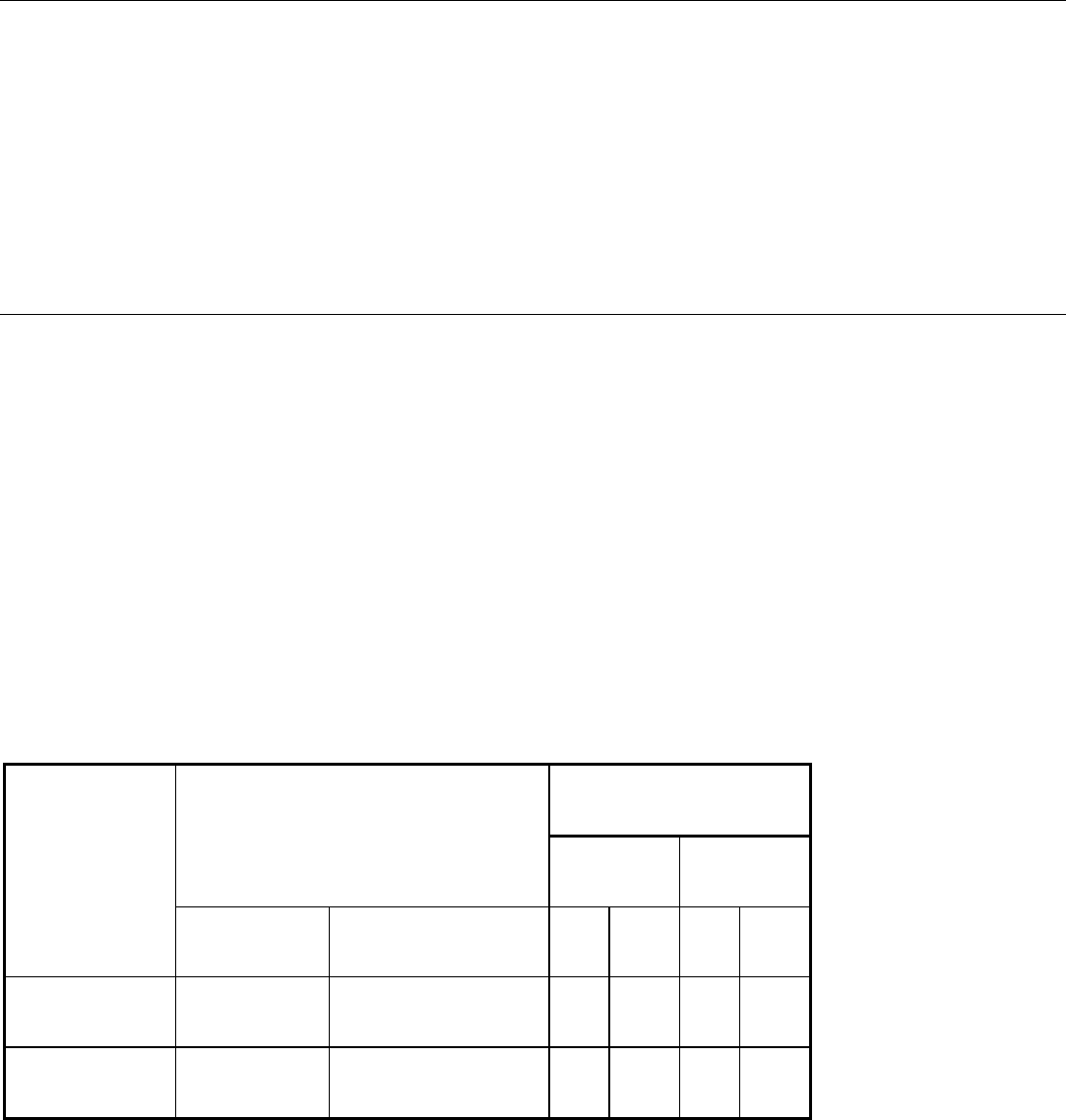
• Pie
rce a 4.88 mm (0.192 in.) wide slot and a 5.11 mm (0.201 in.) square hole, and lance and form two
ears, all in a compound die for accurate relative position (2000 pieces per hour)
• Bend the ends down, locating on the ears (1000 pieces per hour)
• Drill four holes 4.90 mm (0.193 in.) in diameter in a multiple-
spindle drilling machine (500 pieces per
hour)
• Drill small hole next to square hole (500 pieces per hour)
The short-run method required eight times as many man-hours per 1000 pieces as the progressive-die method, and the
brackets produced were less accurate.
Piercing of Low-Carbon Steel
Use of Transfer Dies
Transfer dies are used for piercing in applications that are similar to those for which progressive dies are used. A number
of operations are done in successive stations of the transfer die.
Blanking, cutoff, lancing, notching, forming, and drawing (as well as piercing) can be done in transfer dies. The method
differs from progressive-die operation in that the workpiece does not remain attached to the strip for feeding, but is fed
from station to station by transfer fingers. Production quantities must be large enough to justify the cost of tooling and
equipment.
Piercing of Low-Carbon Steel
Accuracy
Accuracy in the dimensions between pierced holes is highest for holes that are pierced by the same die in one press
stroke. Accuracy in the location of holes relative to an edge or some other feature is highest when the workpiece is
blanked and pierced (or pierced and trimmed) in the same stroke in a compound die.
When the above procedures are used, total tolerances of 0.25 mm (0.010 in.) on hole location and 0. 13 mm (0.005 in.) on
hole size are readily met in normal production, and closer tolerances can be met with suitable tools, as indicated in Table
4. Tooling cost and per-piece cost usually increase in piercing to closer tolerances. Accuracy is typically somewhat lower
for holes pierced by different dies or in different stations of a progressive or transfer die because of piloting and nesting
tolerances.
Table 4 Typical accuracy in piercing
For holes that are pierced with a conventional die in the same press stroke. L
ocation will be less accurate for holes that are pierced
with different dies, or pierced in different stations of a progressive die or a transfer die.
Total tolerance on pierced holes
Die retainers used
Location
(a)
Size
(b)
Finish on tools
Typical material
Locating holes for tools mm in. mm
in.
Commercial ground
1020 or 4130
(c)
Drilled in a drill press 0.25 0.010 0.13
0.005
Commercial ground
1020 or 4130
(c)
Jig bored and jig ground 0.10 0.004 0.13
0.005

Precision ground 4130
(d)
Jig bored and jig ground
0.05 0.002 0.03 0.001
(a)
Relationship between hole centers or between hole center and edges or other reference points on the workpiece.
(b)
Diameter for round holes, or other control dimension for holes of other shapes.
(c)
Can be hardened; other grades of steel also can be used.
(d)
Hardened and tempered before being jig ground
Tolerances smaller than the lowest given in Table 4 can be met with the use of special tooling and gaging and close
control over the press operations, but only at increased cost and a lower production rate. The use of shaving to produce
holes to a tolerance of less than 0.025 mm (0.001 in.) in size is described in Example 11. The use of fine-edge blanking
for improved accuracy and edge quality is discussed in the article "Fine Edge Blanking and Piercing" in this Volume.
Accuracy of hole location is increased by the use of a rigid stripper, precisely aligned on guideposts, to guide the punches.
Typical clearance of round punches in the stripper (using drill bushings as guides) is 0.005 to 0.013 mm (0.0002 to 0.0005
in.) total. Lubrication is important in dies that have such close clearance between punches and stripper. At speeds of 40
strokes and more per minute, the die must be lubricated constantly with a spray of light machine oil to prevent galling of
the punches in the guides.
Accuracy often requires that holes be pierced after forming. In some cases, it may be necessary to pierce a hole after
forming in order to avoid distortion of the hole. In Example 8, holes on opposing flanges were cam pierced in one stroke
after forming for accurate alignment. In Example 7, two slots were pierced in flanges after forming, instead of being
machined, for accurate alignment and location.
Noncritical holes, for which there are no close tolerances on size or spacing, can be pierced for venting (to provide for
free passage of air or other fluids), for lightening, for improved bond with a molded plastic cover, for increased flexibility
of a workpiece, and even to provide controlled strength. In the following example, noncritical holes were pierced to
weaken a part so it would deflect under impact or shock loading.
Example 3: Piercing Noncritical Holes.
The workpiece shown in Fig. 9 is a wheel spider that was designed to be enclosed in molded plastic and to deflect under
impact load. The spider was made of hot-rolled 1008 or 1010 steel, dead soft, pickled and oiled. The steel strip, 3.2 mm
( in.) thick by 406 mm (16 in.) wide, was hand fed into a two-stage progressive die in a 4 MN (450 tonf) mechanical
blanking press. In the first stage, noncritical holes were pierced to make the spider deflect upon impact and to provide a
better bond with the molded plastic. The piece was blanked in the second stage. The pierced blanks were then fed into a
5.3 MN (600 tonf) mechanical forming press, where the part was formed. The forming die was sprayed with soluble oil.
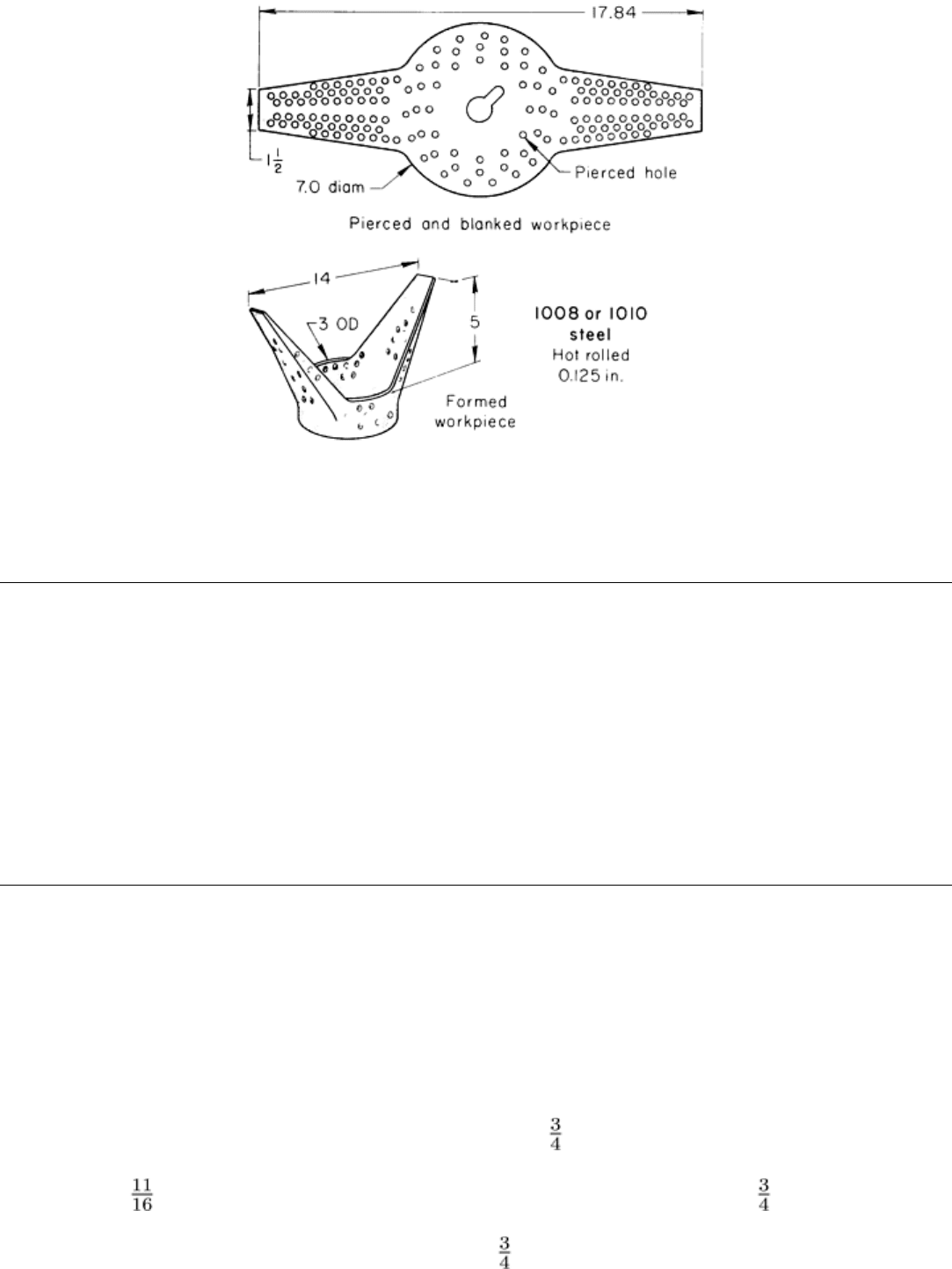
Fig. 9
Wheel spider in which noncritical holes were pierced for deflection under impact and to improve bonding
to plastic. Dimensions given in inches
Piercing of Low-Carbon Steel
Hole Size
Pierced holes can be of almost any size, ranging from holes as small across as the thickness of the stock to the largest size
that can be adapted to the equipment available. Some holes can be pierced that are smaller across than the stock thickness,
but such piercing is not common.
Small holes and slots are pierced in much the same manner as large holes, but small holes are more difficult to pierce
because slender punches are comparatively weak. To minimize deflection and breakage, punch length is limited to that
needed for the operation, and punches are specially stiffened and guided (Fig. 6). The minimum hole size that can be
pierced in a specific application is ordinarily found by trial.
Piercing of Low-Carbon Steel
Piercing of Thick Stock
The effects of work metal thickness on piercing are generally the same as on blanking. Cutting force increases with
thickness; consequently, tool design and material, press selection, and operating conditions are influenced by work metal
thickness. The relationship between die clearance and work metal thickness is discussed in the sections on die clearance
in this article. The minimum pierced hole size is usually expressed as a function of work metal thickness, as described in
the preceding section. The following example illustrates the piercing of unusually thick flat workpieces prior to forming.
Example 4: Piercing a Square Hole in 19 mm ( in.) Plate.
A hole 17 mm ( in.) square was pierced through high-strength low-alloy steel plate 19 mm ( in.) thick in a die in a
1.1 MN (120 tonf) open-back inclinable press. The die was made to pierce holes one at a time in any of several flat
workpieces. A typical workpiece size was 19 × 305 × 940 mm ( × 12 × 37 in.).
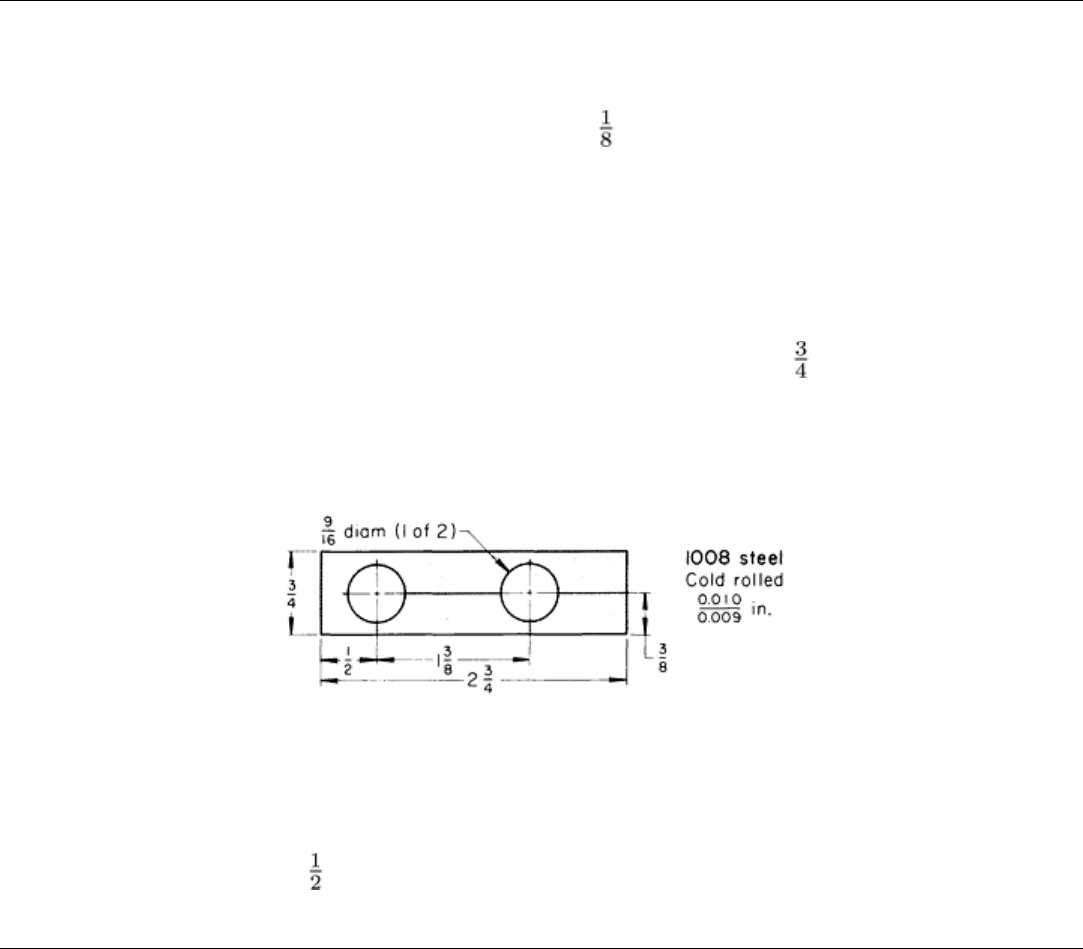
The production rate for piercing in D2 tool steel dies was 300 to 360 pieces per hour. Maximum yearly production was
1000 pieces.
After the holes were pierced, the workpiece was heated to 815 °C (1500 °F) and formed into a curved shape. The shape
was used as a digger bucket--one of many that were bolted to a large wheel (digger rim) of a machine used for digging
trenches for sewers and pipelines.
Radial Piercing of Curved Surfaces. The radial piercing of thick curved workpieces is done in the same manner as
the piercing of flat workpieces, except that the die must be designed to accommodate the curved parts. The piercing of a
hole through round stock, such as a radial hole through a cylinder, is done by using a die with a heavily loaded stripper,
both of which fit the round shape of the workpiece. The round hole is then readily pierced with little bulging of the
workpiece, even though the hole can be as large as 40% of the diameter of the workpiece. The center of the hole should
be at a distance from the end of the workpiece that is at least equal to the work thickness (diameter of the rod).
Piercing of Low-Carbon Steel
Piercing of Thin Stock
Because of its strength and rigidity, material thicker than 3.2 mm ( in.) is seldom blanked or pierced from coil stock or
in a progressive die. On the other hand, material thinner than 0.51 mm (0.020 in.), because of its lack of strength and
extreme flexibility, generally requires special handling techniques. The following example describes the blanking of steel
shims from thin coil stock in a compound die.
Example 5: Piercing of Shims from 0.25 mm (0.010 in.) Strip in a Compound
Die.
The shim shown in Fig. 10 was made from coil stock of cold-rolled 1008 steel, 19 mm ( in.) wide by 0. 25 mm (0.010
in.) thick, in a pierce-and-cutoff compound die. Thickness tolerance was +0, -0.025 mm (+0, -0.001 in.). The coiled strip
was fed automatically from a stock reel by an air-operated slide feed into a 220 kN (25 tonf) open-back inclinable press
that operated at 150 strokes per minute.
Fig. 10 Shim that was pierced and cut off from thin coiled strip in a compound die. Dimensions given in inches
The die, made of oil-hardening D3 tool steel, produced 230,000 shims before it needed sharpening. Die life was indefinite
because a thickness of 38 mm (1 in.) had been provided for grinding allowance in repeated sharpenings in order to
restore the cutting edge.
Piercing of Low-Carbon Steel
Hole Spacing
Recommended minimum spacings for pierced holes are given in Table 5. These minimum spacings apply when ordinary
pressworking practices are followed, without confinement of the workpiece in the die or other special procedures to
prevent distortion.

Table 5 Recommended minimum spacings for pierced holes in flat and formed steel and nonferrous metal
workpieces
Dimension
Work metal
thickness
(t), mm (in.)
Minimum distance,
mm (in.)
<1.57 (0.062)
3.05 (0.120)
1.57-9.65
S
1
and S
2
(0.062-0.380)
3.05 (0.120) (but at least 1.5t
(a)
<0.81 (0.032)
1.52 (0.060)
0.81-3.18
(0.032-0.125)
2t
3.18-9.65
S
3
and S
4
(0.125-0.380)
2.5t
(a)
For steel. Minimum for nonferrous metals, 2t.
(b)
For flanges with no relief. Value for S
5
can be reduced when work metal is relieved for bending (as shown at lower left above) to prevent
distortion of the pierced hole in forming.
As noted in Table 5, S
5
(the distance from the edge of a hole to the inside of a flange) can be reduced when the metal is
relieved near the pierced hole (as by a slot) to prevent distortion of the hole in forming. Accuracy in the shape and
location of pierced holes often demands that the holes be pierced after the workpiece has been formed.
When a round hole must be pierced so as to leave almost no metal between the edge of the hole and the edge of the part,
the hole can be cut through the edge in a keyhole shape that minimizes bulging and does not leave sharp points. In the
